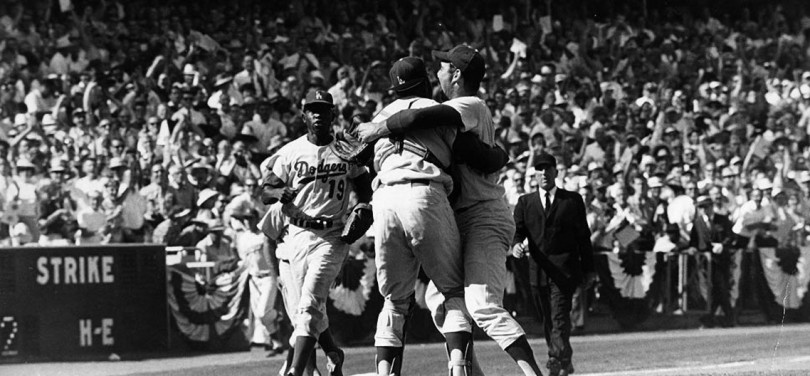
Feature
1963: A Sweeping Success
By Brent Shyer
More than 60 years ago, the 1963 Dodgers won 99 games and a World Championship. Their names still conjure the magic of a proud organization with a rich history – Koufax, Drysdale, Wills, Davis (Tommy and Willie), Podres, Perranoski, Gilliam, Howard, Roseboro, Sherry. Their accomplishments still as relevant and memorable today as they were when the final out was recorded in Game 4 of the World Series at Dodger Stadium.
A team of destiny, perhaps, but a team with heart for certain.
Fairy tale endings were shattered in the Dodgers’ 1962 season. The script had been perfectly crafted until a free Fall. The September swan song saw the sizzling San Francisco Giants gain ground on the first-place Dodgers, who lost 10 of their final 13, and pull into a flat-footed tie at season’s end. Not since July 7 had the Giants led the National League.
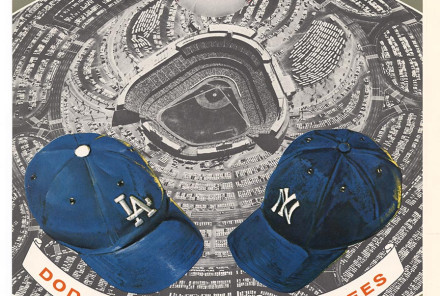
October 1962. Cover page from a phantom program of the 1962 World Series if the Dodgers had won the 1962 National League pennant.
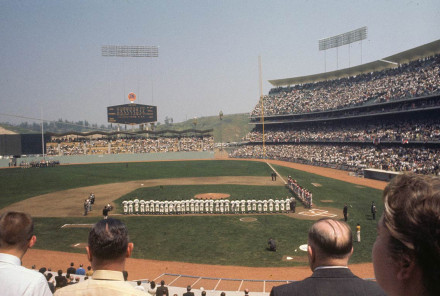
The Dodgers and the Cincinnati Reds line up along the baselines to be introduced for the festivities on Opening Day, April 10, 1962 at Dodger Stadium are underway.
Photo by Peter O’Malley. All Rights Reserved.
Dodger Stadium’s inaugural seal had been broken on April 10 and the home field was a sight to behold, earning vast fan acceptance from the start. Rave reviews poured in about the dream stadium that Walter O’Malley built, privately financed and helped to design. The new ballpark, called by sportswriters “O’Malley’s Taj Mahal,” was so disparate from the cavernous and unique Los Angeles Memorial Coliseum, which served as the Dodgers’ temporary home from 1958-61, had the Dodgers literally off and running.
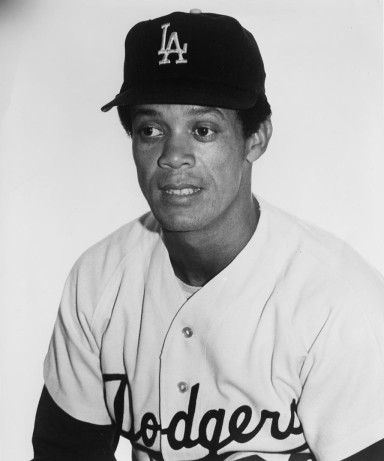
Speedster Maury Wills stole a major league record 104 bases – shattering Ty Cobb’s mark of 96 – and was named National League MVP. The Dodgers won 102 games, third highest total in franchise history, but it still was not enough to win the pennant from the rival Giants, who defeated them in a three-game playoff series.
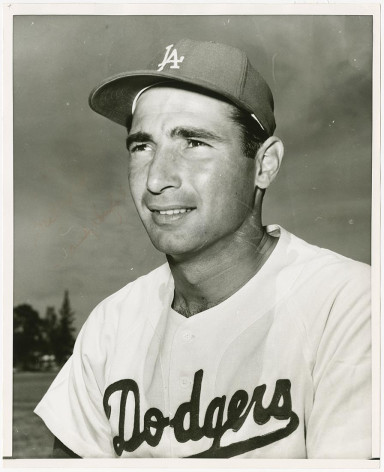
Sandy Koufax is one of the all-time great baseball and Dodger heroes. The left-handed pitcher threw four no-hitters in four consecutive years (1962-1965), including a 1965 perfect game against the Chicago Cubs at Dodger Stadium. He was inducted as the youngest player ever into Baseball’s Hall of Fame in 1972 at 36. Koufax had a 165-87 record and was a four-time Dodger World Series champion (1955, 1959, 1963, 1966) and two-time World Series MVP (1963 and 1965). He won the National League Cy Young Award three times (1963, 1965, 1966) when it was awarded only to one pitcher.
The 1962 season had its own trial, as ace pitcher Sandy Koufax, who led the N.L. in earned run average at 2.54, was sidelined in mid-July with a circulatory problem in his left hand. Despite the Dodgers’ lead in the standings, that condition would serve as perhaps the biggest blow of the season. Koufax did return to pitch four games in September/October, but went 0-2.
The late Giants’ charge whittled away at the Dodger advantage, until there was none. The Dodgers lost the first playoff game 8-0 to the Giants, but bounced back to win game two, 8-7 and force the third and final game for the N.L. Pennant.
Leading 4-2 going into the ninth inning, the Giants stunned the Dodger Stadium crowd with a comeback and sent the Dodgers packing, 6-4. Dodger Executive V.P. and General Manager Buzzie Bavasi said not winning in 1962 “was my biggest disappointment.”
The bitterness of defeat was somewhat altered when, as a way of saying thank you to his hard-working employees, O’Malley made arrangements for his front office executives and staff to attend one game of the World Series in, of all places, San Francisco! It was a way for the employees and their spouses to unwind from the rigors of opening a new stadium and the tough six-month grind. “You all worked real hard,” O’Malley said. “Let’s go up and see the ball game.” Associated Press, October 5, 1962
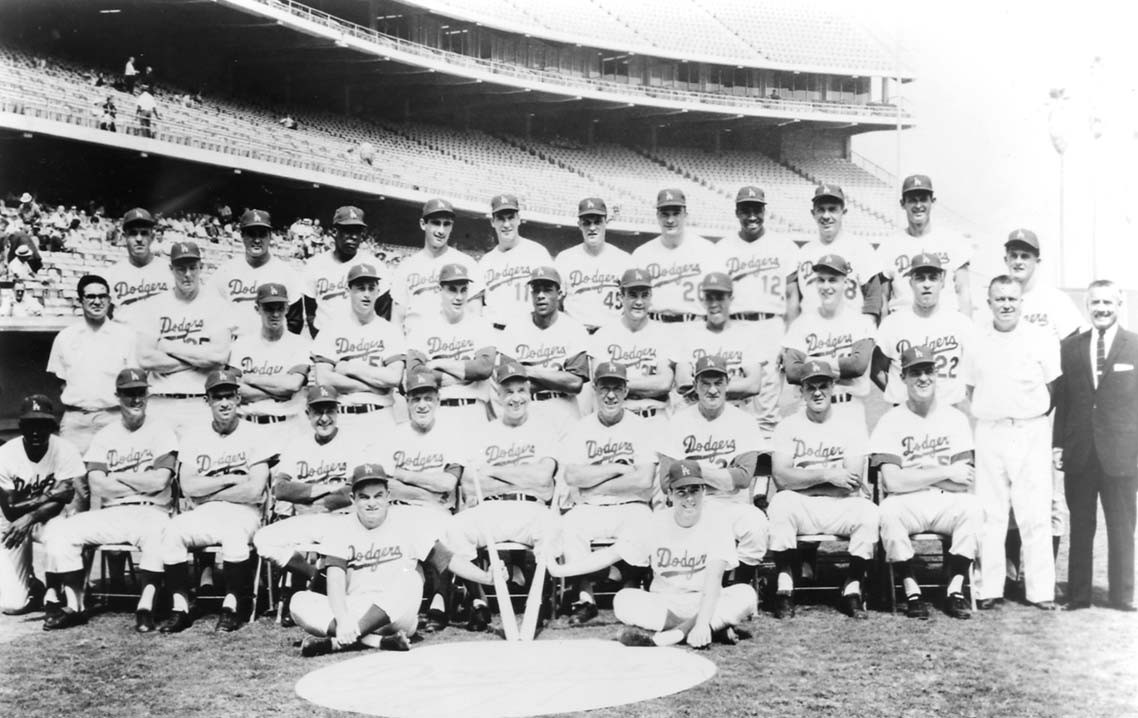
1963 Los Angeles Dodgers
Back Row: Marv Breeding, Ron Perranoski, John Roseboro, Sandy Koufax, Ken McMullen, Pete Richert, Al Ferrara, Tommy Davis, Carroll Beringer (Batting Practice Pitcher), Lee Walls
Second Row: Bill Buhler (Trainer), Frank Howard, Dick Tracewski, Larry Sherry, Ken Rowe, Willie Davis, Doug Camilli, Maury Wills, Bob Miller, Johnny Podres, Dick Calmus
Front Row: Jim Gilliam, Ron Fairly, Wally Moon, Greg Mulleavy (Coach), Leo Durocher (Coach), Walter Alston (Manager), Pete Reiser (Coach), Joe Becker (Coach), Bill Skowron, Don Drysdale, Wayne Anderson (Trainer), Lee Scott (Traveling Secretary)
Seated in Front: Bob Barisoff - Ballboy, Jim Reynolds - Batboy
Copyright © Los Angeles Dodgers, Inc.
Then, as to refocus on the job ahead, when that trip was over, O’Malley told his executives, “The 1963 season starts today.”
Thus began the proverbial journey to reach the top.
When the 1963 season rolled around, three major changes were afoot at Dodger Stadium.
First, O’Malley spent $1.5 million to beautify the Dodger Stadium landscaping, planting more trees, flowers and bushes than the National Park Service. Second, Koufax’s circulatory problem was not an issue and, though many made important contributions to the success of the 1963 team, he would be the difference. Finally, longtime popular Dodger center fielder Duke Snider had his contract sold to the New York Mets on April 1 at age 36. Snider’s absence marked the end of an era from the Dodger teams of old Ebbets Field. In his 16 seasons with the Dodgers, Snider had played in six World Series and smacked 389 home runs. Also departing that season were infielder Don Zimmer, pitcher Ed Roebuck and third baseman Daryl Spencer.
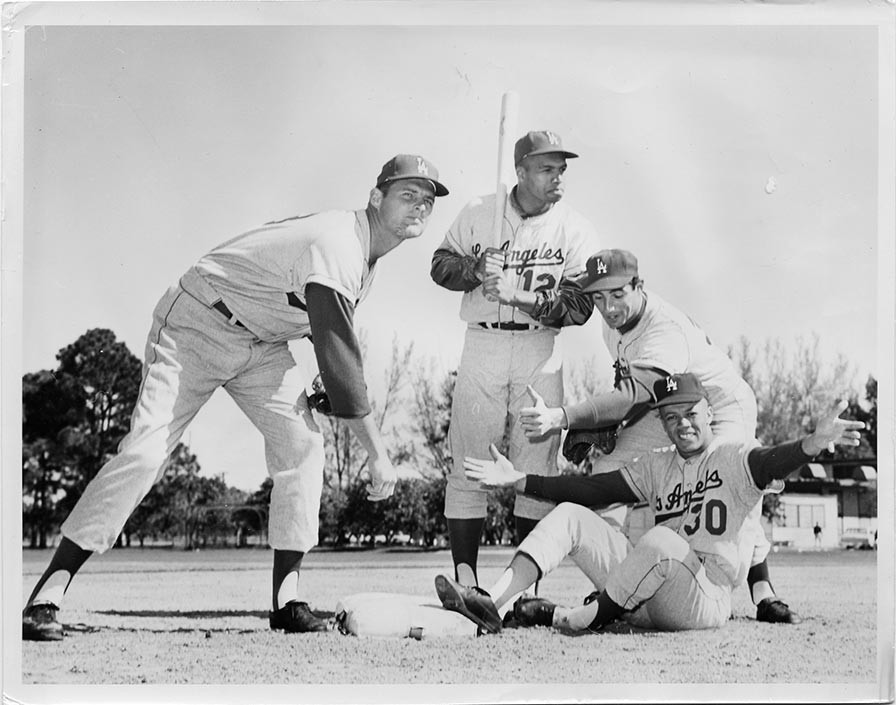
(L-R) Don Drysdale; Tommy Davis; Sandy Koufax; and Maury Wills. Circa 1963, Spring Training at Dodgertown, Vero Beach, Florida, Dodger stars in a light-hearted moment. The four players had superb 1962 seasons with Drysdale winning the Cy Young Award with 25 victories; Koufax won 14 games and was now considered one of the best left-hand pitchers in the game; Davis led the National League in hitting with a .346 average. Wills was the 1962 National League MVP and stole 104 bases to set a major league record.
For Dodger Manager Walter Emmons Alston, the fresh beginning of the blossoming season was just what was needed after the heartbreak of 1962. As the years passed by since his hiring for the 1954 season, Alston had established his position as a most likeable, quiet but strong, leader of the Dodgers.
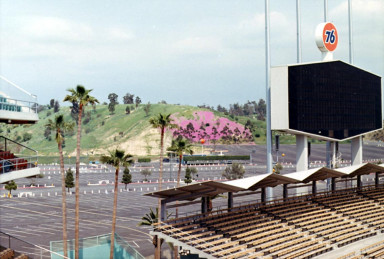
Following the Dodgers’ inaugural season in 1962, Walter O’Malley continued to improve the property, planting a colorful assortment of flowers in the hills above center field.
Alston wrote the following in his 1963 preseason prospectus: “Overall, I’d say the Dodgers have even better speed than last year, a chance at greater power, and, barring injury, better pitching. And I expect fewer mistakes than in 1962. These boys are a year older and they’ve been through a tough campaign. This could be a crucial year for the club in its rebuilding program. If we get by without physical setbacks, I like our chances as well as the next. But you never know in the National League. All the last-minute disappointment of the 1962 season probably never would have come about for the disastrous injury to Sandy Koufax.”
Health was not a concern for Koufax in 1963.
With Koufax 14-3 before the All-Star Game, he was well on his way to one of his most prolific seasons. His season for the ages included a brilliant 25-5 record and record-setting performances, including a National League high of 306 strikeouts. Imagine this – in 1,443 innings pitched through 1963, Koufax had fanned 1,474 batters!
Koufax threw 11 shutouts in the course of the 1963 season, a major league record for a left-handed pitcher, breaking Carl Hubbell’s mark of 10 set 30 years before. He shattered the Dodger shutout record, previously seven in season by Burleigh Grimes in 1918 and equaled by Whit Wyatt in 1941. His ERA was the lowest in the National League for the second straight season, this time at a minuscule 1.88. Koufax’s .833 winning percentage was the highest recorded in the N.L. by a pitcher who won at least 25 games. For the second consecutive season, he tossed a no-hitter, an 8-0 blanking of the Giants at Dodger Stadium on May 11. “Dandy” Sandy went 11-1 at Dodger Stadium and was a perfect 5-0 in September.
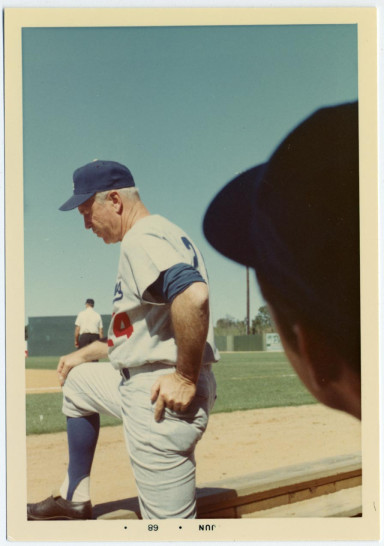
Dodger Manager Walter Alston (#24) on the steps of the dugout prior to a Spring Training game.
But, for all the excitement that was to come in October, the Dodgers did not jump out of the gates in the 1963 season very hot, as they were only 10-11 in April. A 17-9 May made more momentum as they turned towards summer. But, it took a May 6 blowup on the team bus by Manager Alston to coalesce the Dodgers into a team and help turn around the season. On the road in Pittsburgh, heading to the airport to fly to St. Louis, Dodger players were outwardly vocal about the team bus and the cramped seating conditions to their traveling secretary Lee Scott. Once Alston got wind of their many complaints, he asked the driver to pull the bus over to the side and stop.
“Can everybody in the back hear me?” said Alston, gaining all the passengers’ attention. “OK, I’ve heard enough wrangling about what kind of busses we use. Does anybody want to volunteer to check the bus we get in St. Louis?” With no response and dead silence, he said that he would do it himself.
The normally “Quiet Man” continued, “We’re not gonna ride in a better bus or a worse bus than the other clubs do, but if any of you don’t like the bus I get, you come to me and we’ll step outside and discuss it among ourselves. And that goes for all of you.” And with that laying down of the law, the team dropped its compulsive complaining and focused on baseball. Frank Finch, Los Angeles Times, May 7, 1963
The Dodgers, who were 12-14 at the point, won 15 of their next 19 games to improve their record to 27-18 by May 28.
In a winning season, there seems to be one opposing team that is used to clean up on and, for the Dodgers, it was the New York Mets. In just their second year in existence, the Mets could only beat the Dodgers twice in 18 meetings.
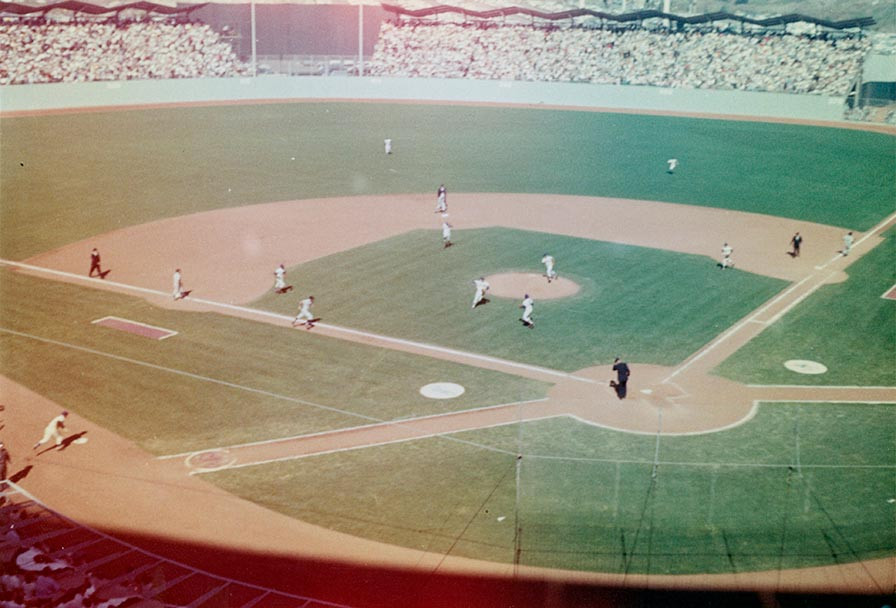
The Dodgers swept the New York Yankees in the 1963 World Series, winning the final two games on their home field, Dodger Stadium on October 5 and October 6. Dodger President Walter O’Malley said he felt good about the 1963 sweep of the Yankees.
Outfielder Tommy Davis was a major contributor to the success of both the 1962 and 1963 seasons. Brooklyn native Davis batted .326 in 1963, coming on the heels of a .346 average the previous season. He won the National League batting crown both years. At the age of 24, he was the youngest player to win back-to-back batting championships. Although he was hard-pressed to match his, and baseball’s, top RBI total of 153 in 1962, “T.D.” did contribute 88 and added more key hits. He assured himself a spot on the N.L. All-Star team when he batted a torrid .355 in the month of June. When the Dodgers made their September push, it was the consistent Davis who hit safely in 24 of his 26 games that month and his success did not stop in the World Series.
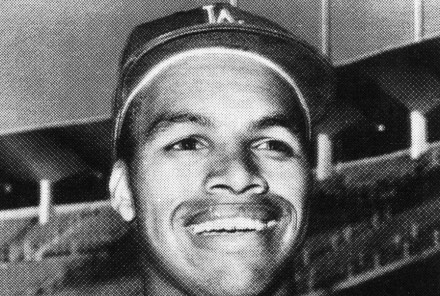
Tommy Davis played for the Dodgers from 1959-1966 and was a two-time National League batting champion (1962 and 1963).
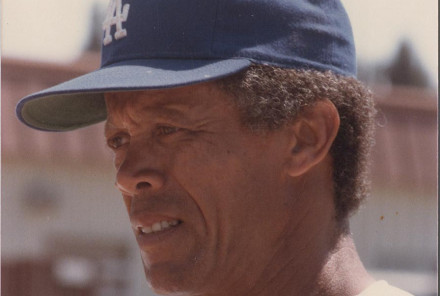
Maury Wills changed the course of baseball with his daring and speed on the basepaths. After spending 8 1/2 years in the minor leagues, Wills earned his opportunity to play shortstop for the Dodgers midway through the 1959 season. He helped lead the Dodgers to the 1959 World Championship. Wills, who learned how to switch-hit with the assistance of Bobby Bragan, played for the Dodgers from 1959-1966.
Davis, Koufax, pitcher Don Drysdale and shortstop Wills represented the Dodgers in the All-Star Game at Cleveland’s Municipal Stadium. Used as the Dodgers’ clean-up hitter in 112 games, Davis collected 13 of his 16 home runs and 66 of his 88 RBI in that lineup spot.
Wills was coming off a “Mr. Everything” season in 1962 – N.L. MVP, N.L. Gold Glove winning shortstop, Major League Player of the Year by The Sporting News, All-Star Game MVP and stolen base champion. Dodger fans’ chant “Go, Go, Go” to encourage Wills’ running game was stymied in 1963 as a leg injury in the first game of the season hampered him, but he still managed to swipe 40 bases, his fourth consecutive season atop the National League. The strong, but compact Wills, at 5’10”, added the Dodgers’ top streak for batting with a 17-straight game skein from June 4-21, as he hit .452 in that stretch.
Drysdale’s numbers were not entirely indicative of the success he had in 1963. He was 19-17 overall, led the league with 42 starts and pitched in 315 innings, striking out 251. He had a 2.63 ERA. What he lacked was run support from his teammates.
Even with all of the top performances, the Dodgers were challenged for the N.L. Pennant. In hot pursuit of the Dodgers from August 28 when they were 72-60, the St. Louis Cardinals won 19 of 20 games to bring them within a game of the league leaders. While the Dodgers won 13 of 19 in the same stretch, they could not fly away from the Cards.
With a riveting pennant race sizzling down the stretch, the Dodgers played a three-game series in St. Louis on September 16-18, a Monday through Wednesday. The Dodgers (91-59) entered the series leading the Cardinals (91-61) by one game, but equal in victories. It was to be a showdown of magnificent proportions.

Dodger President Walter O’Malley deemed the series so important that he arranged for the three games to be televised locally on KTTV Channel 11 in Los Angeles, with the station deriving all revenues from sponsor Union Oil. It was only the second time since the Dodgers arrived in Los Angeles in 1958 that any road games, other than from San Francisco, would be televised.
While the Dodgers were away from home, Dodger Stadium became the site of a September 16 Republican public rally as Arizona Senator Barry Goldwater, running for U.S. President in 1964, spoke before 42,317, the largest crowd to attend a GOP rally “here since former Presidential candidate Thomas E. Dewey appeared in Memorial Coliseum during the 1944 White House race.” Richard Bergholz, Los Angeles Times, September 17, 1963 More than 46,000 tickets had been sold for the GOP rally at $1 apiece. In addition, approximately 400 individuals attended a $100-a-plate dinner at The Stadium Club prior to the formal speech.
Viewers at home pushed the ratings to the highest on record, reflecting the enormous interest in the Dodgers and the race. On Monday, the Dodgers scored a 35 rating and a 65 share of the L.A. market during the first half hour of the telecast. The rating tracks the percentage of every TV set in the Southern California area, whether turned on or off, while the share figure represents the percentage of all sets that are turned on. The next closest competitor was the CBS Big News which had a 7 rating and 13 share.
Writing in his TV column in the Los Angeles Times, Cecil Smith said, “If you were one of the three people in Los Angeles who turned away from the Dodgers-Cardinals game Monday, you might have seen a new monster show called ‘Outer Limits.’ It was awful.” Cecil Smith, The TV Scene, Los Angeles Times, September 18, 1963
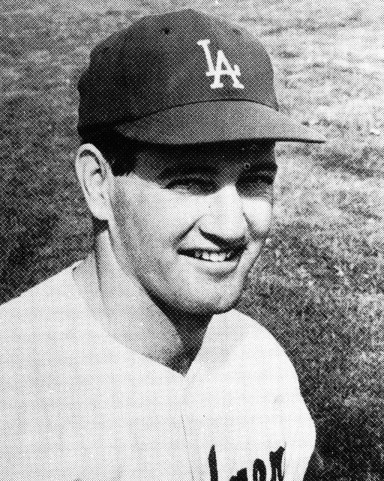
Dodger first baseman Dick Nen, 1963.
As famous and popular as king Koufax was in baseball circles, it still would take a virtual unknown Dodger to lift the team to the N.L. Pennant. Dick Nen, making his major league debut in a critical game against the second-place Cardinals in St. Louis, got an opportunity to bat, pinch-hitting and leading off the eighth inning. He lined out to center field. But, he remained in the game and in the ninth inning with the Cards leading 5-4, Nen hit a dramatic Dodger home run to tie the score. Eventually, the Dodgers won the game in 13 innings, 6-5, to sweep the series. With the Cards’ chasing, it was a difference for the Dodgers of being either four games ahead or two games up with nine to play. Nen’s name was a rare palindrome in baseball history, having been preceded by Truck Hannah, Johnny Reder and Eddie Kazak.
While Nen’s mother Wilma was unaware of her son’s heroics at the time, as she attended a weekly Wednesday evening testimony meeting at the 33rd Church of Christ, Scientist in Los Angeles, Nen’s father was glued to the TV set. “I had a hunch that Dick would hit for the pitcher in the eighth inning,” said proud papa Sam Nen. Bud Furillo, “The Rookie”, Los Angeles Herald Examiner, September 19, 1963

Coincidentally, it was Nen’s only hit as a Dodger and he had just eight at-bats in seven games in 1963. But, what a memorable at-bat that turned out to be for him and his teammates. On the spot, it earned him consideration for a World Series share, as voted by the Dodger players, even though he was ineligible for the postseason for the late-season call-up. He did not collect another hit until 1965 when he was playing for the Washington Senators against the Angels at Dodger Stadium.
The Dodgers, with their 99-63 record, eventually held off the Cards to win the N.L. Pennant by six games. In 51 one-run games, the Dodgers were 33-18.
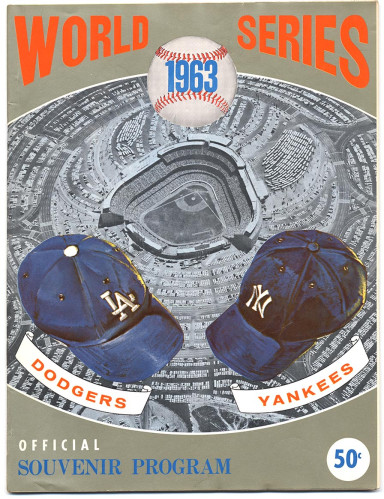
October 5 and 6, 1963. The Dodger 1963 World Series program cover featured caps from the New York Yankees and the Los Angeles Dodgers with beautiful Dodger Stadium in the background, which had opened a year earlier. Don Drysdale shut out the New York Yankees, 1-0 in Game 3 and Sandy Koufax defeated the Yankees, 2-1 in Game 4 for the only Dodger World Series sweep and the third World Championship overall.
Although time had marched on, two old rivals were to face each other once again. This time, though, they were separated by a few thousand miles. But, the long World Series history between the Dodgers and the New York Yankees, from their first meeting in 1941 to 1963 certainly invoked memories of the struggles involving these two titans. The Yankees dominated in 1941, 1947, 1949, 1952, 1953, while the Dodgers captured their first World Championship in 1955. In 1956, the Yankees won the World Series, Game 7, a 9-0 shutout at Ebbets Field. Overall, the Yankees had won 20 World Series.

The Yankees won the American League Pennant by 10 ½ games over Chicago. Whitey Ford won a league-leading 24 games, followed by Jim Bouton’s 21 and a 2.53 ERA. Catcher Elston Howard had 28 home runs and 85 RBI, while first baseman Joe Pepitone added 27 homers and 89 RBI. Injuries, in 1963, set back the Yankees, as center fielder Mickey Mantle played in only 65 games and right fielder Roger Maris played in 90. At the tail end of his Hall of Fame career, catcher Yogi Berra was limited to just 64 games.

Koufax dominated, as usual, winning two World Series games, Games 1 and 4. He bested Ford in Game 1 on October 2 in New York, 5-2, striking out 15 Yankees to set a World Series record. Southpaw Johnny Podres, who captured memorable Game 7 of the 1955 World Series for the Dodgers at Yankee Stadium, also won, giving up six hits, this time in Game 2 in New York, 4-1. Dodger bullpen ace Ron Perranoski got the last two Yankees out to earn the save.

As the scene shifted to Los Angeles, 3,000 energized fans greeted the Dodgers at LAX. Arriving in the Dodger-owned Lockheed Electra II airplane known as “Kay O’”, the Dodger players and executives waded their way through the crush of media and fans to get home.
Los Angeles City Councilwoman Rosalind Wyman, the individual most responsible for encouraging the Dodgers to relocate to Los Angeles, and California Governor Edmund G. “Pat” Brown hosted three young runaways (ages 11 and 12) who had left Phoenix by bus and arrived four days earlier in Los Angeles with the dream of attending a World Series game. After they made a visit to MacLaren (juvenile) Hall, the boys were treated to Game 3 in box seats made available by Wyman and Gov. Brown. A day earlier after learning of their plight, considerate Wyman said, “We’ve arranged to meet at the ballpark. Then we’ll have lunch at the Stadium Club, and then – the game. I don’t mean to encourage runaways, but I think the boys have learned their lesson, and gosh when you’re 12 or 13 years old…a World Series!” Los Angeles Times, “Runaways Will Get to Watch Game After All,” October 5, 1963
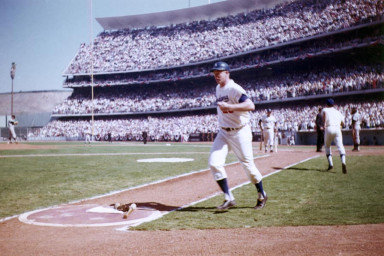
October 6, 1963, Game 4, 1963 World Series. Slugger Frank Howard is returning to the Dodger dugout after hitting his fifth inning home run for the Dodgers’ first run in Game 4 of the 1963 World Series. Howard’s home run was the first in Dodger Stadium history to be hit into the Loge Level (second deck) in left field. Sandy Koufax pitched a complete game 2-1 win over the New York Yankees and the Dodgers won the 1963 World Series in a four-game sweep.
Drysdale, who rose to the occasion, captured Game 3 at Dodger Stadium on October 5, 1-0, outlasting Bouton. The Yankees had only three singles and struck out nine times against “Big D,” while the Dodgers collected just four hits and made a first-inning RBI single by Tommy Davis stand up. Drysdale’s masterful complete game shutout was clearly one of his best games ever. With a 3-0 lead in the Series, the Dodgers needed one more victory to sew up the title.

Prior to Game 4 at Dodger Stadium on October 6, Eddie Fisher became the first pinch-hitter of the day as he sang the national anthem, in lieu of scheduled Anna Maria Alberghetti, who was ill. Ceremonial first pitch honors went to Bob von Eps of Long Beach Peterson Post championship Junior Legion team pitching to Justin Dedeaux (son of former Dodger and legendary USC baseball coach Rod Dedeaux) of USC’s national collegiate champions.
For Game 4, Koufax arrived at the stadium wearing colors of the San Francisco Giants in an orange sweater and black pants, while his rival was Ford again. The Yankee starter almost missed the game, as he reached into his shaving kit and sliced his right index finger with an exposed razor blade. “I don’t know what made me reach with my right hand, but I’m sure glad I did.” Los Angeles Times, October 6, 1963 Although the left-hander could make his starting assignment, he still wouldn’t be able to stop his team’s bleeding.
The Dodgers managed only two hits, including big Frank Howard’s massive 450-foot, fifth-inning home run that, for the first time, reached Dodger Stadium’s Loge Level seats in fair territory and put them ahead, 1-0. The Yanks tied the score in the seventh inning on Mantle’s mammoth 400-foot home run. The Dodgers forged ahead 2-1 in the bottom of that inning on a crucial error by Pepitone, who lost Clete Boyer’s throw at first base in the white-shirted crowd that sent Jim Gilliam scampering all the way to third base, where Willie Davis hit a sacrifice fly to center to score him. That finished the Series scoring.

With eight more strikeouts, Koufax’s second win to complete the World Series sweep was accomplished in one hour and 50 minutes before 55,912 fans at Dodger Stadium. After jumping for joy on the mound, Koufax was presented with a new Chevrolet Corvette as the World Series MVP.
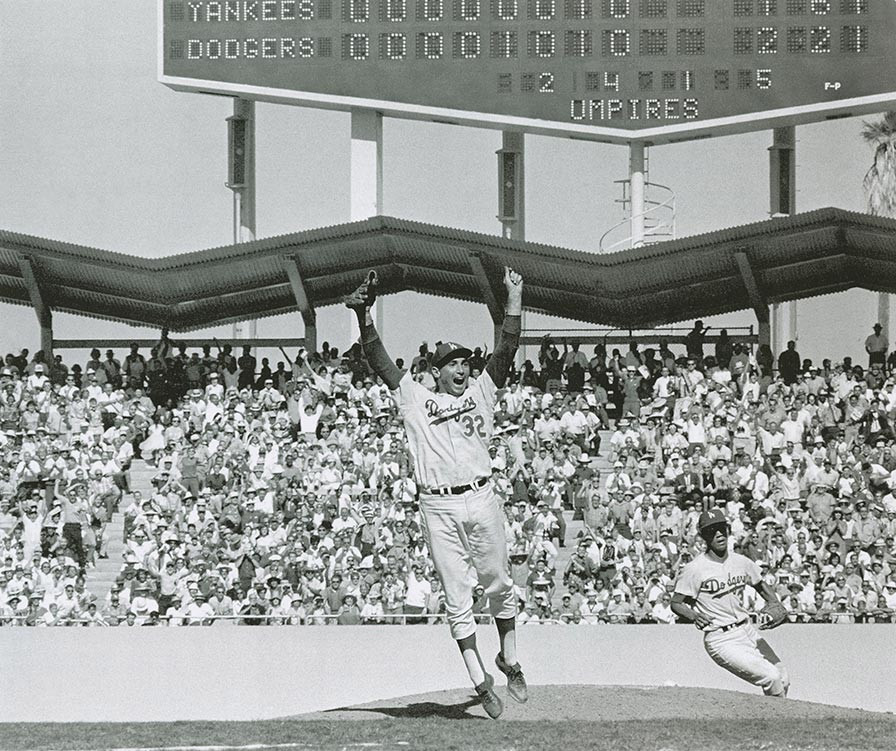
October 6, 1963, Game 4, 1963 World Series Dodger left-handed pitcher Sandy Koufax exults at the final out of the 1963 World Series in Game 4, as the Dodgers sweep in four games the visiting New York Yankees at Dodger Stadium . Koufax, who was named Series Most Valuable Player, beat the Yankees, 2-1, in Game 4 to earn his second World Series win in two starts. Shortstop Maury Wills, number 30, is in the background who fielded the final grounder and threw to first baseman Bill Skowron. Koufax won Game 1 and Game 4 of the 1963 World Series and would be named the 1963 World Series Most Valuable Player by Sport magazine. This is the only Dodger World Championship won on their home field.
“That was a fun ballclub as far as I’m concerned to play on and to watch,” Koufax reminisced years later. “You had so many different kinds of guys. When I say different, you had Frank Howard, who was not quite your standard baseball player; and Willie Davis, who ran so well; and Tommy Davis, who was probably the best hitter in baseball at that time; and Ron Perranoski having a great year in the bullpen; and Maury Wills changing the game again from a game that had not had many stolen bases. In 1962, he just turned the game around again and continued to do it in ’63. We had some great pitchers in Drysdale and Podres.
“It was just a fun team to be on. It was just one of those teams that just sort of worked together and the chemistry was good as people, the chemistry was good as players.”
Tommy Davis, whose significant contributions to the success of the Dodgers, continued in the World Series as he batted .400 (6-for-15). “After losing the playoff in 1962, we were determined to win in 1963,” said Davis. “Being able to beat the Yankees four in a row was one of my greatest moments in baseball.”
Dodger pitching, with a league-leading ERA at 2.85, best in 21 years (since 1942), handcuffed the Yankees. The Yanks’ four runs were the lowest total in a four-game Series and they batted only .171. For the Dodgers, it was the 10th straight World Series game in which a rival starting pitcher failed to complete a game (last time was in 1956 Game 7 by Yankees’ Johnny Kucks).
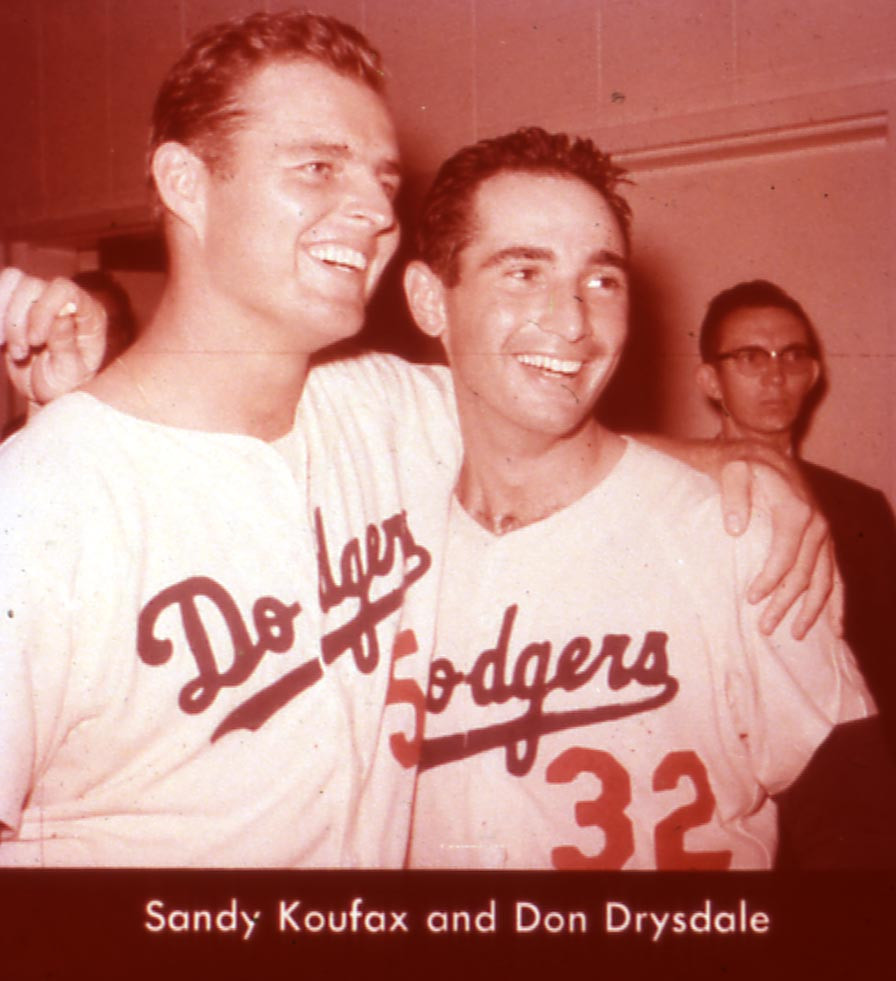
Don Drysdale (left) and Sandy Koufax celebrate in the Dodger clubhouse after Koufax defeated the New York Yankees, 2-1, in Game 4 of the 1963 World Series. With dominating pitching, the Dodgers enjoyed a four-game sweep over the Yankees. Drysdale pitched a 1-0 shutout in Game 3 to keep the Dodgers on their sweep path.
Yankee catcher Howard said, “That’s the best pitching anybody ever threw against us in a World Series.” Phil Pepe, New York World-Telegram and Sun, October 7, 1963
The Dodgers completely dominated the Yankees. The entire World Series took only eight hours and 17 minutes to play! It remains the only time the Dodgers have won a World Championship on their home field.
No championship season happens without the collective contributions of each player on the roster. Heroes, there were many, including Perranoski, who had a 16-3 record and 21 saves with a tiny 1.67 ERA in a league-leading 69 games; Howard and his team pacing 28 home runs; Gilliam and his versatility off the bench with a .282 batting average; and Podres’ 14 wins.
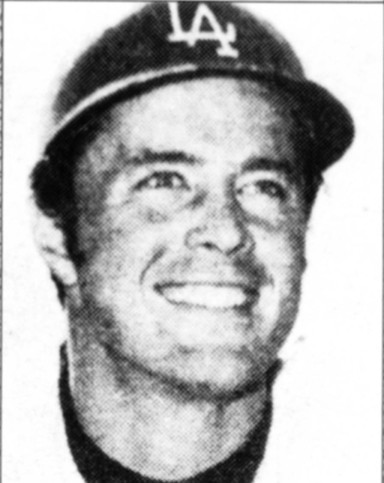
Dodger outfielder Roy Gleason, 1963
One intriguing player on the Dodger roster was a September call-up named Roy Gleason. In his first major league at-bat on September 28 at Dodger Stadium against Philadelphia, Gleason lashed a double down the left field line and scored a run. Although he played in a total of eight games that season and in his career, that would be his only career at-bat, so he has a lifetime 1.000 batting average. He was not eligible for the World Series.
But, his story went far beyond playing for the Dodgers, as, in 1967, Gleason was drafted by the U.S. Army and sent to battle in the Vietnam War, returning as a highly decorated hero. According to his book, “Lost in the Sun,” Gleason is the only person to have played in at least one major league game and serve in the war in Vietnam. In 2003, to commemorate his brave service to our country, the Dodgers invited him to throw the ceremonial first pitch and surprised him with a 1963 World Championship ring to go alongside his Purple Heart.
The 1963 World Series full share amounted to $12,794. Cash awards were granted to call-ups Nen for $1000 and Gleason for $250.
Even as the Dodgers had headed west for the 1958 season, the victory over the mighty Yankees proved to be a breakthrough of sorts for a seismic shifting of dominance from the east coast to the west. The 1959 World Championship by the Dodgers over the Chicago White Sox was an important first step and gained a foothold to the wide fan acceptance in Los Angeles, but the 1963 whitewashing of their longtime rivals from the East – the Bronx Bombers – was an even more eye-opening achievement.
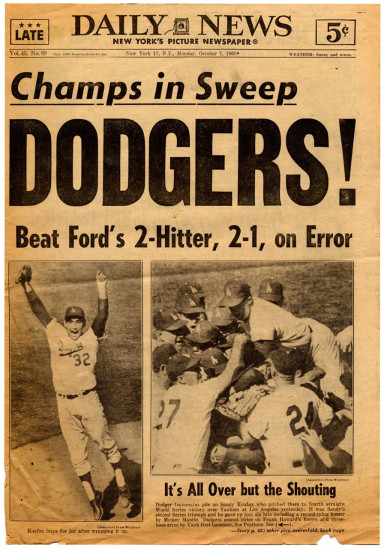
The New York Daily News’ headline of October 7, 1963 tells it all for New York Yankees’ fans as the Los Angeles Dodgers sweep the New York Yankees in four games for the 1963 World Championship. Sandy Koufax, who had pitched and won Game 1 with 15 strikeouts, stopped the Yankees in Game 4 with a 2-1 win. It was the only World Championship the Dodgers have won on their home field.
The westward expansion of baseball by visionary owner O’Malley, who brought the Dodgers to Los Angeles and encouraged the Giants to head to San Francisco, not only had proved popular, but successful as well and had opened the door for other teams to follow, including the Angels in 1961 and Houston in 1962. The growth continued with the Padres, A’s, Mariners, Rangers, Rockies and D’backs, who followed in later years, making 10 teams west of Kansas City, where in 1957 there had been none.
O’Malley once was asked about his most memorable Dodger team? “My favorite team, I guess the year we beat our old enemies (in 1963), the Yankees in four straight in the World Series. That was really, I guess, one of my biggest thrills in baseball, because back in Brooklyn we had played the Yankees so many times in the World Series, almost always seven game Series and they managed to win most of them. We only won there once. To do it in four straight and to say goodbye to the Yankees, I felt pretty good about that. That was a big one!” 1978 interview with Vin Scully, KTTV Special and Bud Furillo interview with O’Malley on KABC
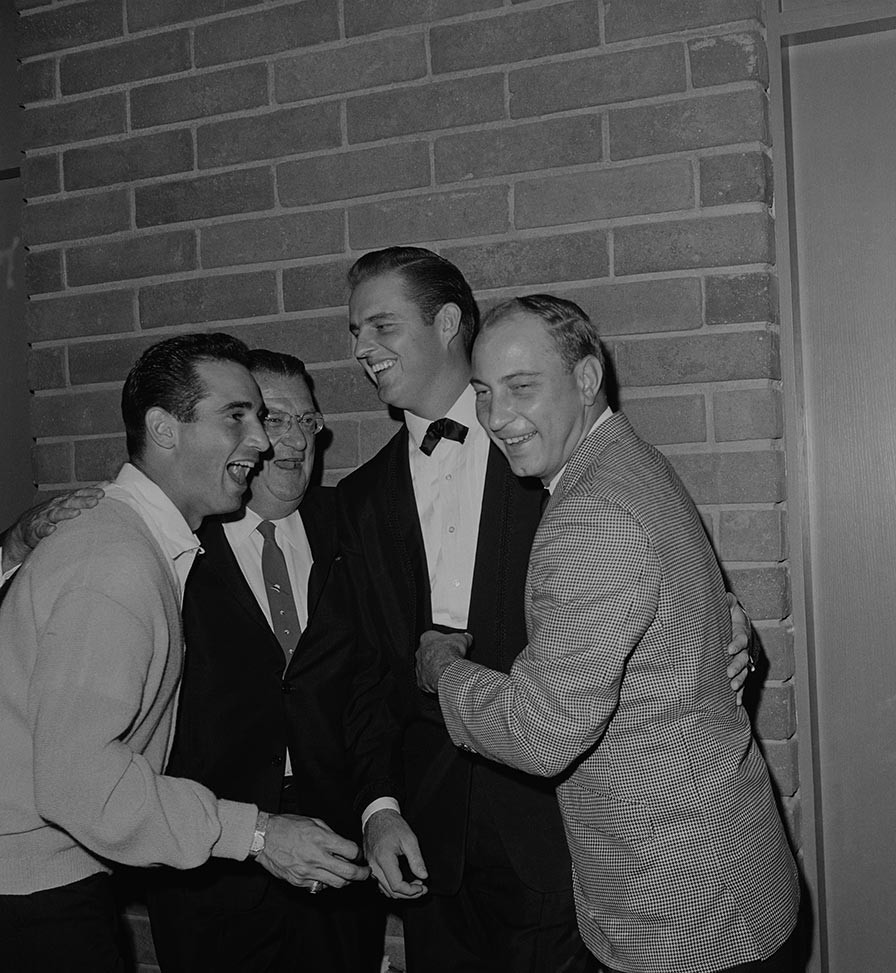
On October 6, 1963, the three winning pitchers of the 1963 World Championship Dodgers are with Dodger President Walter O’Malley. (L-R): Sandy Koufax; O’Malley; Don Drysdale; and Johnny Podres. O’Malley hosts a World Championship celebration at The Stadium Club in Dodger Stadium, as the Dodgers defeated the New York Yankees in four straight games, including a 2-1 Game 4 win earlier that day.
To celebrate in grand style, O’Malley hosted “The President’s Championship Dinner” at The Stadium Club at Dodger Stadium. The players, coaches and executives sumptuous dining experience included Dungeness crab, clear green turtle soup, hearts of palm salad, Chateaubriand and bing cherries jubilee. A commemorative menu printed for the occasion featured four aces fanned out with the words “Four Straight” in the lower corner.
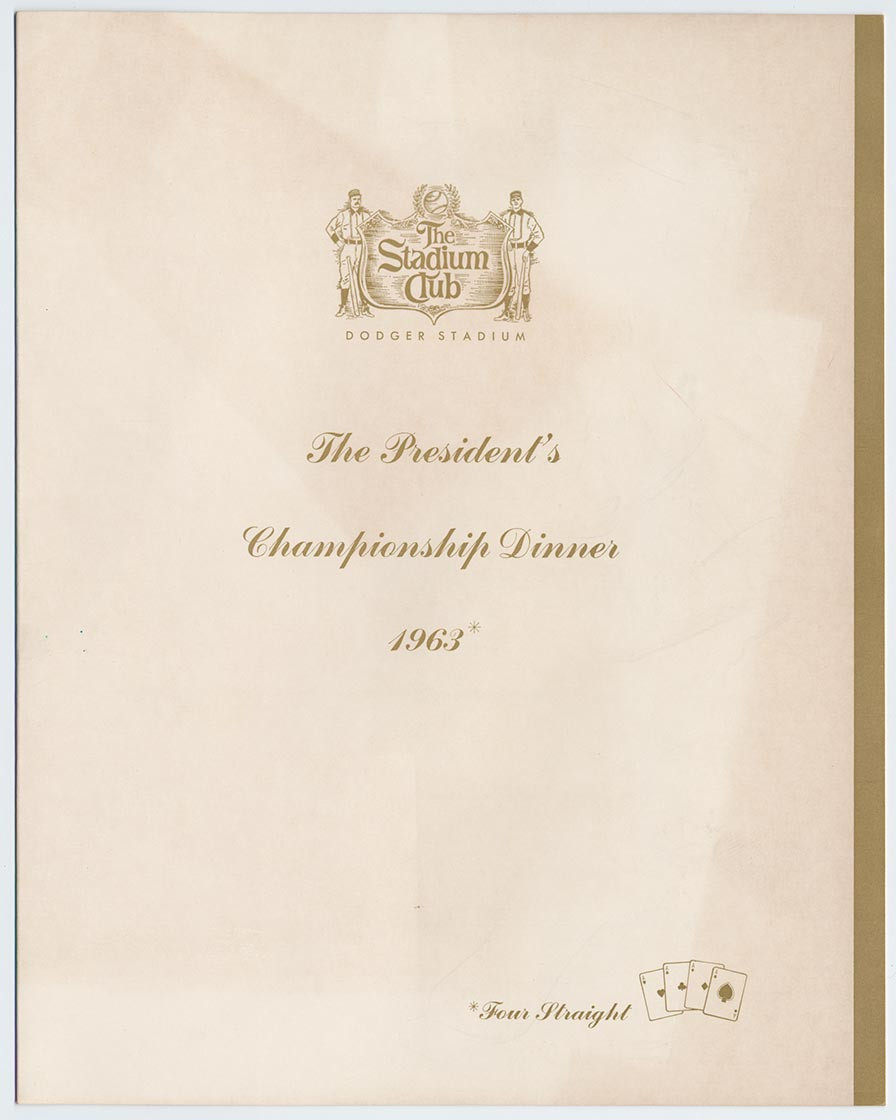
Walter O’Malley hosted “The President’s Championship Dinner” for the Dodgers on October 6, 1963 at The Stadium Club, Dodger Stadium, Los Angeles to celebrate the four-game World Series sweep of the New York Yankees earlier that day. The dinner menu is illustrated with four aces, a nod to the four straight.
The Dodgers’ storybook season established them as the dominant National League franchise and they were able to win two more pennants in the next three years, adding another World Championship in 1965.

